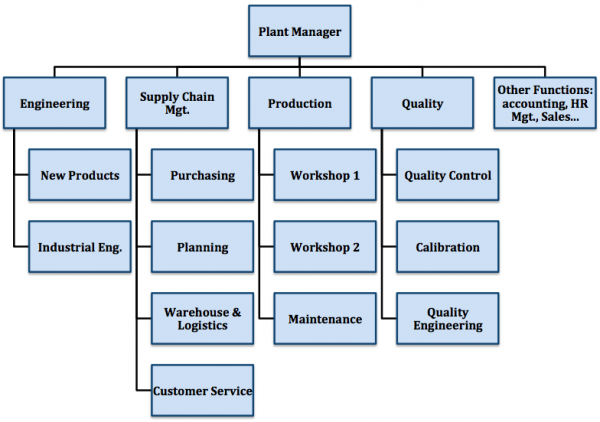A few years ago, I wrote an article on ‘7 Common Mistakes Revealed by Factory Org Charts‘. I described two issues I have seen many times in Chinese factories:
Mistake 1: not having a quality department
Most small workshops don’t have personnel dedicated to checking quality on a full-time basis. The problem is, very often nobody checks quality at all! That’s a serious problem and only importers who can station inspectors on site 24/7 should do business with such suppliers.
Mistake 2: placing the quality department under the production manager
The production department’s focus is naturally to get products out of the door fast, while keeping costs down. So there needs to be someone with authority to say “stop” when quality requirements are not met.
If that someone (the quality manager or one of his subordinates) reports to the production manager, there is an obvious lack of independence.
And I concluded by suggesting this generic org chart, as a starting point for re-thinking a factory’s lines of command.

Looking at formal systems, what else is important, quality-wise?
A lot, actually. Here are some classic candidates:
- Procedures give the quality staff the authority to stop a production run that is creating too many defective parts/products (yet, this is not enough, as we’ll explore below)
- Very clear quality standards, and a good understanding of the customers’ requirements in general
- An appropriate training program for manufacturing (line leaders, operators) and quality staff
- A solid new product introduction process, for new products
- The operators’ pay scheme does not give them an incentive to pass on bad products without saying anything
However, these are not enough!
Have you already audited a factory’s quality systems, found that all was in order, and later found out that their product quality was quite inconsistent?
I have seen this many times. Undisclosed subcontracting is one reason behind it. But, in some cases, production is really done in-house, the quality staff knows there are problems, the production also knows it, and yet the good are still shipped out.
Going one level deeper: looking at the managers’ personalities
The quality manager needs to have at least as much ‘natural authority’ as the production manager. If the quality manager doesn’t have a strong personality, doesn’t want to take responsibility for his/her decisions, and/or tends to evade conflict, it is dangerous.
Production managers are usually pushy by nature. They want to get products out of the door, to hit their numbers. There is no time to waste. They will tend to roll over any weak quality guy standing in their way.
If the quality manager feels he doesn’t have full support from top management, that’s a risk amplifier. How can he/she step up and take responsibility for actions that have an economic impact on the organization? Without a thick skin and some confidence, he won’t put his head on the line.
As always, it comes down to management. Spot a sneaky owner, run away!
—
What do you think? Have you seen such a scenario play out? What counter-measures can be put in place, if this is at play in an organization?
Ultimate Guide To Sourcing From China And Developing Your Suppliers [eBook]
This FREE eBook starts from the beginning, discussing whether you need to hire a sourcing agent, and follows the sourcing process right through to developing a trusted supplier’s quality and productivity.
There are 15 chapters over 80+ pages to explore, providing exhaustive guidance on the entire sourcing and supplier development process from start to finish, including:
- Identifying suppliers,
- Negotiations,
- Quality inspections,
- Developing Chinese suppliers,
- Improving factory quality and productivity,
- and much more…


